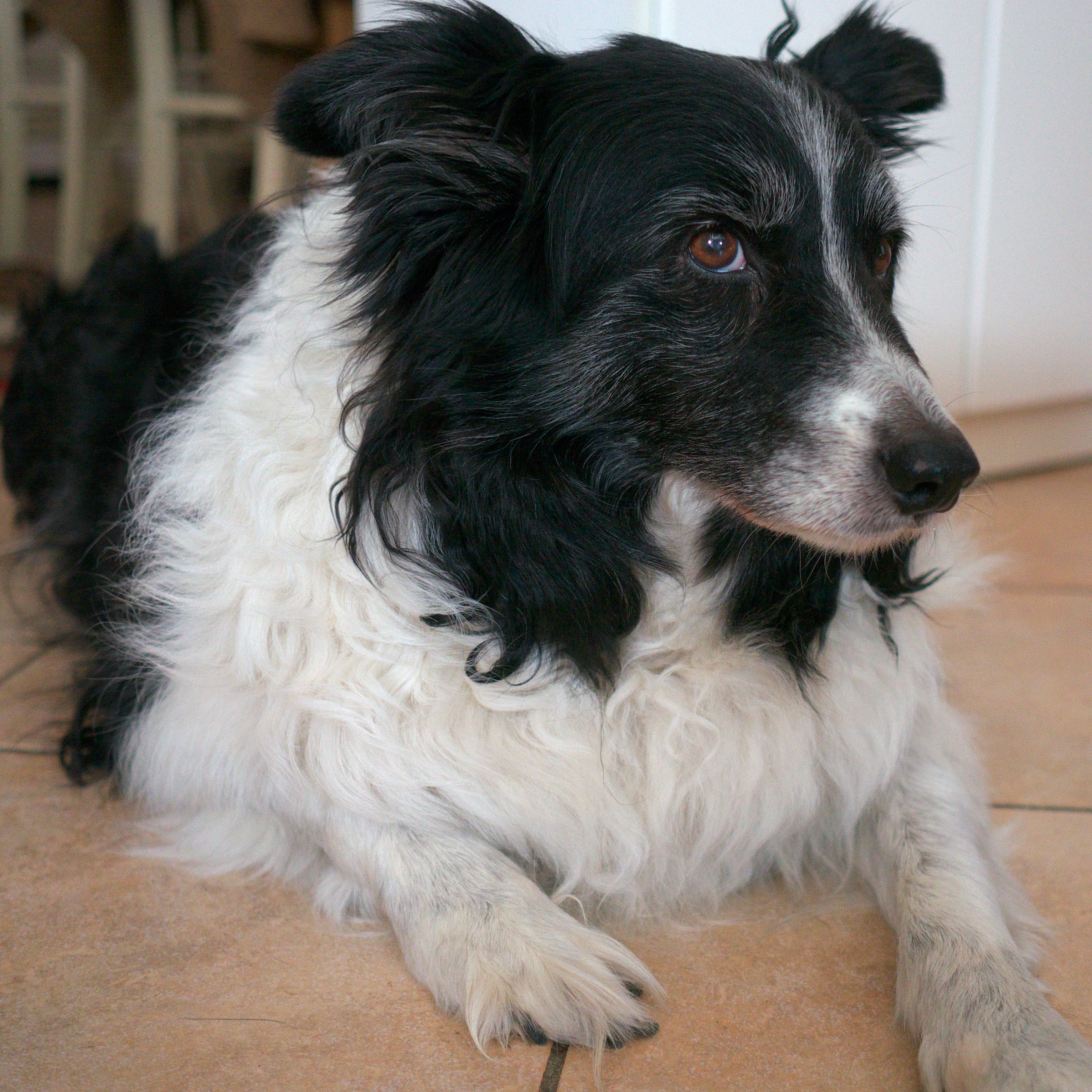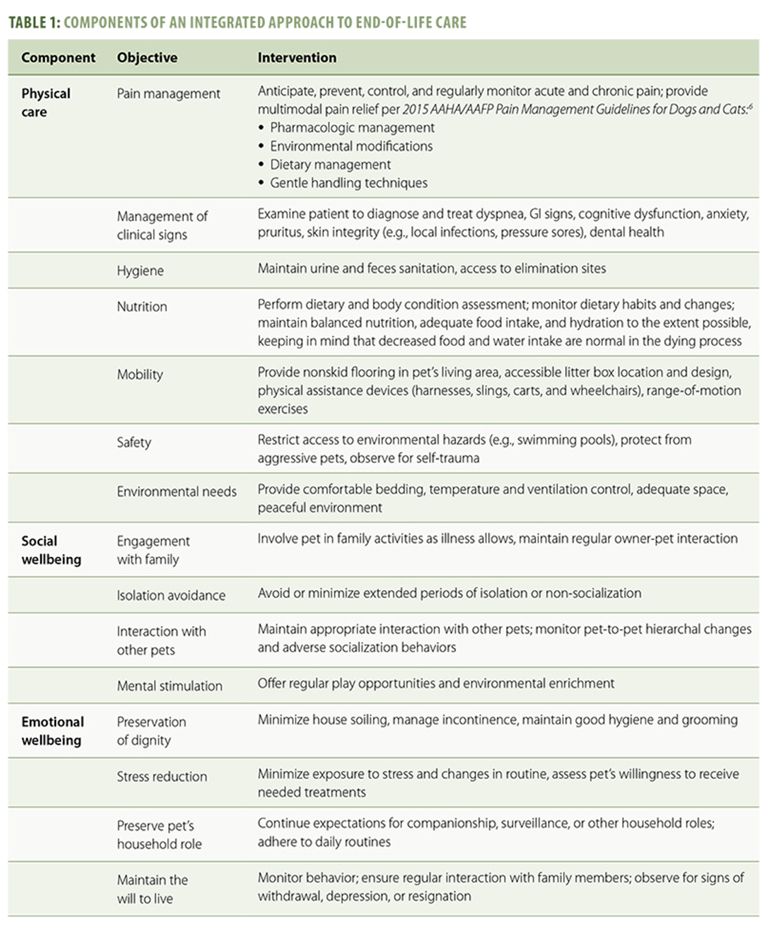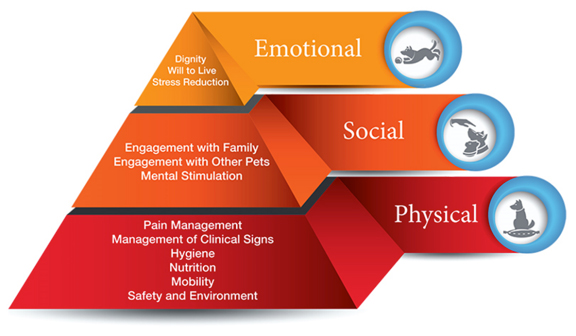Dignified life and death after a terminal cancer diagnosis
9
9.1
There might come the time when cancer treatments have failed or cannot be started because the cancer has already advanced too much. The imminent or sudden death of a beloved pet is usually very emotional. The decisions to be made can be overwhelming. That’s the moment you must take your time to think and discuss with your veterinarian about new options to make the last stage of your dog’s life as dignified and peaceful as possible.
Indeed, our relationship with our pets is very special. We acquire our pets for lifetime companionship and unconditional love. We assume responsibility for their health and welfare. We rarely think that one day we might be faced with life-threatening illness or life-or-death decisions. Even though illness and death are part of the life cycle, it is something we just don't think about, don’t want to think about.
Sadly, no matter how good a job we do or how successful we are, no matter how healthy our pet's life has been, no matter how committed we have been to provide the best of health care, severe illness and death cannot be avoided.
It is certainly a very difficult moment in our common life, but if we try to see the end-of-life care for our dogs as a wonderful way to keep our bond strong, to thank our pet for all the wonderful time we were able to spend together, we both – owner and pet – will benefit emotionally from the experience. That’s how I experienced the heart-breaking moments of illness and saying good bye to the biggest love in my life, to my Alice. The last couple of weeks of our life made our relationship unforgettable, very special, enriched and enhanced.
The object of this chapter is to provide resources - information, tools and support - for all dog owners who are going to accompany their pet in its final hours, in both preparing for and getting through this inevitable stage of life - and, to quote Simone de Beauvoir, in helping their loved one to have “Une mort très douce”. Hopefully, some of the information below will help you to face some of the very difficult decisions to be taken at the last stage of your dog’s life, and to make it a very special moment – despite being heart-breaking.
9.2
If you are considering accompanying your terminally ill dog through to the last stage of his life and death, ask yourself the following questions before rushing into decisions:
- How much money am I prepared to spend, how much can I spend for end-of-life care?
- If extensive nursing care is needed, do I have the time? Or will it seriously disrupt my regular family and work obligations?
- Do I have adequate resources to provide constant care for my pet, even when I am out of the house?
- How many other people or dogs are affected by the patient’s illness, death?
- Is my home suitable for the care of a terminally ill dog?
- How do I know it is time to say good bye? Can my pet just pass away naturally or is euthanasia indicated? If so, when?
- What is quality of life for a dog? A quality of life scale may be a good indicator of when to start palliative care - at home or in a hospital – or opt for euthanasia.
- What is in-home hospice care and it is available where we live? Is hospice care possible at my home? Do I have a local veterinarian whose expertise includes the most advanced techniques in pain management, alternative treatments, oxygen and hydration?
- Hospice care may or may not include euthanasia. Do I have a veterinarian available 24 hour a day to provide emergency euthanasia if my pet’s suffering gets out of control, such as the sudden onset of seizures?
- What about care of my pet's remains?
- What about grief-support for me and my immediate family (including children and other dogs)?
Your family veterinarian will be in a good position to advise you during these difficult times as he/she has had the time to get to know you and your pet – most of the time since puppyhood. If you haven’t had a solid, trusting relationship with your vet over the life of your pet, it’s worth finding another vet who you can better relate to. It’s now more than ever that you need someone to trust.
Resource and further reading
→ apahvet.com
→ http://kerstin-piribauer.at/
9.3
What is End-of-Life care?
9.3.1

End-of-life care is if your pet is suffering from a terminal illness and a cure is not possible.
End-of-life care is complex and includes, in addition to physical care with medication and adapted nutrition, also the social factor (maintaining the interaction with the family and other pets in the household) and the emotional factor (maintaining the dog’s role within the family, reducing stress factors, maintaining dignity).
The following chart will show you what end-of-life care - the physical, social and emotional support of your dog - implies in practice:

Option 1: Hospice care or palliative care
9.3.2
We all want to choose a kind of end-of-life care for our furry friends which will keep our bond strong.
If your dog’s last memories are of being stuffed into a transport box and a nauseating car ride to a vet that has only brought discomfort, pain and anxiety, what does that do to your bond? And to your memories of that relationship? Would in-home palliative or hospice care be a more ethical option for your dog? Your pet may be more comfortable in a familiar environment or around familiar companions.
What is animal hospice or palliative care?
It is a philosophy or program of care that addresses the physical, emotional, and social needs of animals in the advanced stages of a progressive, life-limiting illness or disability.
Palliative care or hospice care: Although similar, there are a few variables that distinguish palliative from hospice care:
- Palliative care can be administered alongside curative treatments, or on its own. Palliative care does not necessarily imply that end-of-life care is needed at this point. In fact, many pets undergoing palliative care can live comfortably for many years. Although curing your pet’s condition may not be possible, the symptoms and the suffering can be reduced by giving palliative care.
- Hospice care is end-of-life management. It is not a place, but a personal choice and philosophy based on the principle that death is a part of life and can/must be dignified. The goal of pet hospice is not to cure your pet’s illness but rather to ensure a peaceful end-of-life experience. Animal hospice care is provided in the familiar and secure home of the patient from the time of a terminal diagnosis through to the death of the animal, inclusive of death by euthanasia or by hospice-supported natural death. Animal hospice also addresses the emotional, social, and spiritual needs of the human caregivers in preparation for the death of the animal and the grief experience. It is enhanced when provided by an interdisciplinary team.
During this last stage of your dog’s life, your pet’s conditions are monitored more closely as its quality of life decreases. Pain management and other palliative measures are increased to ensure your pet is as comfortable as possible. If the pain becomes unmanageable, it is time to initiate the end-of-life plan (natural death or euthanasia) implemented and discussed before treatment began.
What are the goals of hospice care?
The focus is to make a pet’s final days or weeks more pleasant with the proper use of pain medications, dietary strategies and human interaction. This hospice care includes:
- controlling pain
- assessing appetite and deciding whether or not to stimulate it
- improving mobility
- improving quality-of-life through supplementary therapies such as massages, acupuncture, essential oils, whole nutrition, nutritional supplements
- adjusting medications
- addressing the emotional suffering of the animals and providing mental stimulation
- providing accompanied and assisted natural death or meaningful euthanasia, if chosen.
Both hospice and palliative care philosophies not only hope to provide relief from your pet’s physical pain, but also help him maintain a rich, emotional environment until his final moments.
A participating veterinarian will teach pet owners how to provide intensive home care to keep an ill pet as comfortable as possible.
What is the pet owner’s role in hospice or palliative care?
1. You become your pet’s nurse and caregiver
Hospice or palliative care requires an active commitment from pet owners, who work closely together with their veterinary team to make sure of their pet’s quality of life. Your pet will require your constant supervision — from assessing his condition on a daily basis or, if necessary, making the final decision to opt for euthanasia. You will become your pet’s primary nurse and caregiver, as well as the link between your pet and the veterinary team.
Pet owners who opt for home hospice or palliative care will be taught how to administer pain medication, change bandages, provide fluid therapy and perform general nursing duties, including keeping their pets comfortable, dry and clean.
2. You will have to monitor your pet’s pain levels
Since pain management plays a major role in palliative and hospice care, the veterinarian will give you techniques for how to spot pain in your pet. It is important for you to objectively monitor your pet’s pain levels so that treatment can conform to your pet’s needs.
3. You will have to monitor and improve your pet’s quality of life
Your pet’s quality of life needs to be carefully monitored throughout the palliative and hospice care process. You should provide an area in your home that contains:
- comfortable pet bed
- easy access to food and water
- comfortable room temperature
- soft, comforting music
- non-slip flooring
- respite from other pets and children
Below you will provide a Quality-of-Life-scale for you to monitor your pet’s quality of life. If your pet’s quality of life begins to diminish, the doctor may increase palliative therapies. When palliative therapies stop working, the end-of-life plan may need to be initiated: assisted natural death or euthanasia.
4. You will maintain a close collaboration with your veterinarian
One of the most important tasks as caretaker is to observe and report any changes in your pet’s behaviour, weight, temperature, eating habits, mobility and overall well-being. If you notice any changes, you immediately have to contact your veterinarian, who will adjust your pet’s medication and treatment accordingly.
5. Your devoted love and care mustn’t prolong the pet’s suffering
Although hospice and palliative care are growing areas of veterinary medicine, we need to be very careful not to prolong the suffering of pets who are in pain or experiencing poor quality of life. It is very difficult to face losing a pet, but our choices must not be clouded by fear of the grief we will experience.
Option 2: In-hospital care
Option 2: In-hospital care
9.3.3
Palliative treatments might begin in the hospital, where your dog might have to stay overnight for a couple of days. Your pet will often be visited and supervised by the hospital’s health team to assess his health and treatment program. When your pet is treated in hospital, the doctor has the benefit of having access to all that the hospital has to offer, allowing your pet to receive the care it needs at any time.
Most hospitals allow dog owners to visit their dogs during the day.
Resource and further reading
→ END OF LIFE CARE
→ Hospice & Palliative Care
Option 3: Humane (dignified) euthanasia
Option 3: Humane (dignified) euthanasia
9.3.4
Humane euthanasia is the intentional termination of life by human intervention utilizing approved methods that cause minimal pain, discomfort, and anxiety in order to relieve an animal’s suffering.
Sadly, our duty to our beloved, terminally ill pet doesn’t end with ensuring that they feel secure, surrounded by their loved ones, provided with a comfortable sleeping spot and well adapted nutrition and medication. Caring for a terminally ill dog often leads to one of the hardest decisions we are going to have to make: Assuming the end of life is inevitable (assisted natural death or euthanasia).
Euthanasia is recommended when palliative therapies are unable to maintain an acceptable quality of life. Some pets may appear to be peacefully resting, but in fact may be in considerable pain. It is up to you to objectively monitor your pet’s quality of life. When your pet’s quality of life decreases to below an acceptable level, it may be time to consider euthanasia. The guidelines below will help you to evaluate your dog’s quality of life.
During the procedure, your vet will inject your pet with a sedative followed by a special medication. The animal experiences no awareness of the end of life—the process is akin to undergoing general anaesthesia for a surgical procedure and takes about 10 to 20 seconds.
If ever possible, an in-home euthanasia should be preferred, performed by your pet’s referring veterinarian.
Euthanasia, in spite of being a legal and widely accepted tool in end-of-life care, is a double-edged sword. On the one hand, it provides an end to animal suffering when it becomes medically, financially, or physically impossible to maintain the patient’s quality of life. On the other hand, it leaves significant numbers of caregivers struggling with doubts regarding the decisions they made, which prolongs and complicates their grief experience. 50 % of dog owners who had their dog euthanised struggle with their decision (source: AAHA, see below). As the value of animal hospice care and its availability increase, so will the feasibility of ethically managed, high quality, hospice-supported natural death, and the decision to euthanize will become more nuanced.
Resource
→ 2016 AAHA/IAAHPC End-of-Life Care Guidelines*
But how do we know when it’s time to let go?
How do we assess the dog’s quality of life? go to chapter 9.3.6. below.
Quality of life (QOL) assessment tools
Questions that might haunt you ![]()
Do animals remember the past? Do they anticipate the future? Are they capable of self-assessment? Intentionality? Choice? These questions, once believed to be beyond the reach of any science, loom large in the minds of many pet owners/caregivers as they face the decisions they have to make for their pets throughout EOL care. These questions have been under extensive scientific examination in recent decades, and the weight of the evidence indicates that many species of animals do indeed possess some of these capabilities, in widely varying combinations and in different degrees of complexity.
For further reading:
Option 4: Assisted natural death
Option 4: Assisted natural death
9.3.5
If you’ve made the decision to allow your pet to pass naturally, it is very important to monitor his quality of life closely. In choosing a natural death for your pet, it may be difficult to control his pain and maintain his quality of life. It is important to ensure that your dog’s pain, stress and anxiety is being adequately controlled and adequate medication is administered to provide relief.
Insist that your veterinarian to provide necessary and adequate medication.

Option 5: Quality of life (QOL) assessment tools
Option 5: Quality of life (QOL) assessment tools
What is quality of life (QOL)?:
The total wellbeing of an individual animal that covers the physical, social, and emotional aspects of its life.

Resource & picture
https://www.aaha.org/professional/resources/end_of_life_care_guidelines.aspx
Assessing the Quality Of Life (QOL) of your pet can be difficult, but recognizing when it is declining is an important part of ensuring your loved one is comfortable during its last stage of life.
Be as informed as you can about your pet’s behaviour and condition. Being unaware or unable to assess signs and symptoms will put your pet at risk of lingering longer than is comfortable.
Here are some of the things to look out for to understand whether your pet’s quality of life is declining:
1. Pain might reduce your dog’s quality of life.
Refers to an unpleasant or painful experience, feeling, emotion, or sensation, which may be acute or chronic in nature; this is an umbrella term that covers the range of negative subjective experiences, including, but not limited to, physical and emotional pain and distress.
The most important thing you can do for your elderly or ill pet is to minimize any pain or distress they’re experiencing at the end of their life. However, when dogs are suffering, they may not show outward signs that we normally associate with pain, like whimpering or crying. Sometimes an animal will continue to socialize, eat or drink in spite of pain. Some of the physiological and behavioural signs that your pet might be experiencing pain are:
- excessive panting or gasping for breath
- reclusiveness
- hiding in unusual places
- reluctance to move
- food pickiness
- disorientation
If you’re unsure of how much your pet is suffering, keep a daily written record of good days and bad days. Be sure to consult with your veterinarian and treat any health problems (for example loss of appetite, pain), since undiagnosed issues can cause discomfort and rapid deterioration.
Your veterinarian will explain the pain management protocol associated with your pet’s specific condition. Anti-inflammatory drugs may be prescribed if your pet does not have kidney or liver problems. If your pet has severe pain, due to a chronic illness like cancer, your veterinarian may prescribe a narcotic painkiller in the form of oral medication or a patch that is placed on the skin.
2. Irregular behaviours might show that your dog’s quality of life is declining.
Irregular behaviour patterns are often the first sign that your pet is ill or in pain. A pet may lose its normal activity levels and be more apathetic, lose appetite, or may exhibit inappropriate elimination, vocalization and even aggression. Does your pet seem irritable, restless or confused? Does your dog avoid his/her favourite activities, like playing with her ball? Does your pet seek out unusual places to sleep or hide, for example under the bed, table, chair?
3. Protect your terminally ill dog from other pack-members
Other healthy pets in the household may start showing similar abnormal behaviours as a reaction to the changes and distress of your sick animal companion. Be sure to get regular check-ups for all of your pets to monitor and protect against any undiagnosed issues. Let’s not underestimate the fact that animals also experience grief and the imminent loss of a pack member might destabilize the other dogs.
Is your pet being picked on by other animals in the home? This can happen when a sick or elderly dog becomes the weakest member of the “pack”. If this is the case, then separate the dogs and allow your sick dog to stay in a peaceful spot.
4. Incontinence might show that your dog’s quality of life is declining.
Some older or ill pets may develop incontinence, or the loss of bladder control, so be sure to check your furry friend regularly for any wetness or soiling.
If your pet needs help getting up to urinate or defecate, but has difficulty to stand up, you can purchase a sling or use a large towel to wrap under their body and assist them. You might also buy animal diapers (pampers) to lay in the dogs bedding to keep him/her dry during the night.
Resource and further reading
→ END OF LIFE CARE
Quality-of-life (QOL) assessment tool with the help of “Quality of Life Scale” by Dr. Alice Villalobos
9.3.6
Pet caregivers can use this Quality-of-Life Scale to determine the state of their dog: Score patients using a scale of: 0 to 10 (10 being ideal).
|
Score |
Criterion |
|
0-10 |
HURT - Adequate pain control & breathing ability is of top concern. Trouble breathing outweighs all concerns. Is the pet’s pain well managed? Can the pet breathe properly? Is oxygen supplementation necessary? |
|
0-10 |
HUNGER - Is the pet eating enough? Does hand feeding help? Does the pet need a feeding tube? |
|
0-10 |
HYDRATION - Is the pet dehydrated? For patients not drinking enough water, use subcutaneous fluids daily or twice daily to supplement fluid intake. |
|
0-10 |
HYGIENE - The pet should be brushed and cleaned, particularly after eliminations. Avoid pressure sores with soft bedding and keep all wounds clean. |
|
0-10 |
HAPPINESS - Does the pet express joy and interest? Is the pet responsive to family, toys, etc.? Is the pet depressed, lonely, anxious, bored or afraid? Can the pet’s bed be moved to be close to family activities? |
|
0-10 |
MOBILITY - Can the pet get up without assistance? Does the pet need human or mechanical help (e.g., a cart)? Does the pet feel like going for a walk? Is the pet having seizures or stumbling? (Some caregivers feel euthanasia is preferable to amputation, but an animal with limited mobility yet still alert, happy and responsive can have a good quality of life as long as caregivers are committed to helping their pet.) |
|
0-10 |
MORE GOOD DAYS THAN BAD - When bad days outnumber good days, quality of life might be too compromised. When a healthy human-animal bond is no longer possible, the caregiver must be made aware that the end is near. The decision for euthanasia needs to be made if the pet is suffering. If death comes peacefully and painlessly at home, that is okay. |
|
TOTAL |
A total over 35 points represents acceptable life quality to continue with pet hospice (Pawspice). |
Original concept, Oncology Outlook, by Dr. Alice Villalobos, Quality of Life Scale Helps Make Final Call, VPN, 09/2004; scale format created for author’s book, Canine and Feline Geriatric Oncology: Honoring the Human-Animal Bond, Blackwell Publishing, 2007.
Alice Villalobos, DVM, DPNAP, a renowned veterinary oncologist, introduced “Pawspice”, a quality of life program for terminally ill pets. Pawspice starts at diagnosis and includes symptom management, gentle standard care and transitions into hospice as the pet nears death. Dr. Villalobos developed this scoring system to help family members and veterinary teams assess a pet’s life quality.
Resource and further reading
→ 2016 AAHA/IAAHPC End-of-Life Care Guidelines*
Journeys Quality of Life Scale Calculator
9.4
Your family situation
How many people are affected by the illness and possible death of the pet? If it is just you and your pet, then the decision might be easier. But if there are other family members involved in the pet’s life, then their feelings and wishes need to be considered. On whatever road your decision takes you, know that you are not alone. As pet owners we will sometime have to make decisions that we don’t want to for the benefit of our loved ones.
If you have children it’s important that you talk to them about what is happening at every stage. If the pet is sick, then explaining in simple but direct language what is wrong can help remove the mystery from a child’s mind. This gives you the opportunity to show that animal bodies don’t live forever. Then, when the sickness progresses to the point where your pet needs to be euthanized to prevent further suffering, the child will understand it more easily.
When it’s time, and where applicable, allow all of the family members an opportunity to say goodbye to the pet. Some veterinarians will even come to your home to perform the euthanasia. This is an individual decision and may not be appropriate in all situations. The term “euthanasia” means “gentle death,” and when done by a caring professional, can be very releasing for a family after having experienced a painful illness.
Your financial situation
How much money are you prepared to spend? Most of us hate having to look at this. We feel we would do anything humanly possible to save our animals’ lives. But unless you have an insurance plan, many treatment options or specialists today can be very expensive. If you choose an expensive treatment, will your vet allow you to pay over time or pay by instalments? Are you prepared to forgo that vacation you had planned, or the purchase of that giant screen TV?
Your time schedule
If extensive, time-consuming nursing care is needed, do you have the time? Or are you out at work all day? Of course, you want to have the time for someone who has been so important to you and your family. But you need to be realistic. Is everyone out at work or school all day with long commutes back and forth? Some terminally ill pets may need medication twice a day. Or radiation sessions that are on a daily basis. Can you fit that into your schedule?
Your home situation
What kind of place do you live in? Some end-of-life patients need adapted home conditions, special equipment because they might not be able to stand on their feet anymore.
If your dog was used to sleeping outside, it is now essential to provide a warm sleeping spot inside with plenty of cushioning.
Resource and further reading
→ charlestonanimalsociety.org
9.5
9.5.1
Creating a ritual around the life of your pet can be very healing. If possible, lay your pet to rest in a quiet part of your yard and put up a marker with his or her name on it. This can be as elaborate or as simple as you like. A rock with the pet’s name in indelible marker written on it, a piece of wood with the name carved into it, a ring of stones, or a newly planted tree on the site will help family members remember all the good times they had with their pet.
Writing a letter to your pet after he/she has passed away may also be very healing for everybody and a wonderful souvenir of the time spent together.
Create a photo-album with all the adventures, excursions and funny moments you experienced together. This way your furry friend will stay in your heart for ever.
9.5.2
There are several different options for your pet after he has passed:
1. Cremation: Your pet will be cremated at a special crematory in your area. You may choose between a group cremation (your pet is cremated in a group and ashes are spread at a Loving Rest place), or private (your pet is cremated alone, ashes are returned to you in an urn of your choice).
2. Body returned to owner: You may want to keep your pet’s remains for private burial/ cremation. However, please check with your city or country’s government for regulations concerning pet burial.
If you choose cremation, then you can create a place of honour for the ashes, with pictures and stories contributed by everyone in the family. 
Talking about the pet seems to be an important part of getting through the inevitable grieving process. Remembering all the little things that made your pet an important part of your life helps to ease the pain. Animals teach us unconditional love, loyalty, kindness, and a host of other wonderful things. They make us better people. After a period of mourning and remembering the old days, you might think about adding a new animal to the family. You and your family will see that life goes on and that it is possible to love again.
9.5.3
After the loss of a companion animal, many people observe a change in their surviving pet’s behaviour. Sometimes the pet appears depressed and shows diminished interest in play or food, and it often helps to simply give your surviving pet some extra attention and love. If your animal companion appears upset, check with a veterinarian to make sure there is no underlying medical problem causing their behaviour.
It is also well-documented that pets can recognize death in a companion animal. Cats, dogs and horses who see the deceased body of an animal they knew can adjust very well and spend less time searching and grieving than pets who have not seen their companion’s remains.
However, this might also be a traumatic situation - showing the deceased body of the passed away pack-member - so it is up to you to judge what is best for other pets in the household.
Resource and further reading
→ www.charlestonanimalsociety.org









